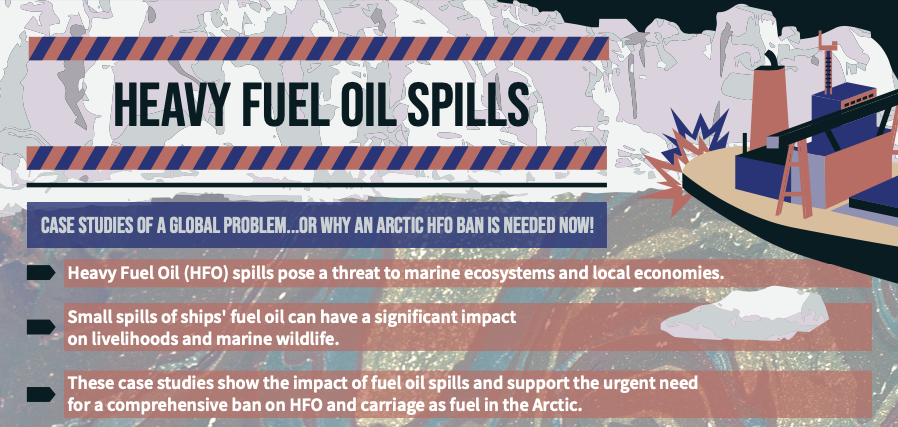Infographic: Heavy Fuel Oil Spills – Case Studies of a Global Problem
In November 2020, a decade after the Arctic Council first identified oil spills as the greatest risk posed by shipping to the Arctic, the International Maritime Organization (IMO) finally agreed to a ban on the use and carriage of heavy fuel oil (HFO). On the face of it, this appears to be a good thing – a solid and timely ban would protect the Arctic marine environment as well as the communities who depend on it, from the risk of a disastrous heavy fuel oil spill, while using fuels cleaning than HFO could curb black carbon emissions from increased shipping in the region.
But the ban is not robust, and will not have the necessary impact anytime soon. It will not come into force until mid 2024, and then only partially, thereby addressing only a small proportion of heavy fuel oil currently being used in the Arctic. This came about due to pressure from the shipping industry, and from Russia in particular, as well as opposition from some large ship registries, including the US, which resulted in an exemption from the ban for ships with fuel oil tanks located inside their double hulls. It also opened the way for a controversial waiver allowing countries with coastlines bordering Arctic waters to issue waivers to allow ships flying their flag to continue using HFO in Arctic waters until July 1, 2029.
As a result, almost 75% of HFO-fuelled ships currently operating in the Arctic will be able to continue using HFO there until mid-2029. This means that only 30% of HFO carriage as fuel, and 16% of its use would be banned when the regulation comes into effect as expected in mid-2024. Final IMO signoff is expected at MEPC76, in June 2021.
Already banned for a decade in Antarctica and in some of the waters around the Arctic archipelago of Svalbard, Norway heavy fuel oil is a viscous and polluting fossil fuel that powers ships throughout our seas and oceans – accounting for 80% of marine fuel used worldwide. Around 75% of marine fuel currently carried in the Arctic is HFO. If HFO is spilled in cold polar waters, it is likely to break down very slowly, and prove almost impossible to clean up, with the costs of response and attempts at clean-up running into millions of dollars. But the costs are not only financial – a HFO spill would have long-term devastating effects on Arctic indigenous communities, livelihoods and the marine ecosystems they depend upon.
Ships burning HFO produce black carbon particles which are emitted in the exhaust fumes. These short-lived climate forcers heat the atmosphere when emitted, and when they fall on snow, on glacier ice and sea ice, the reflectivity (albedo) is reduced and the absorption of heat increases. Black carbon emissions from shipping have already increased by 85% between 2015 and 2019, and more Arctic shipping using HFO will lead to increased black carbon emissions, fueling an already accelerating feedback loop. Recent Arctic Council studies of ship activity in the Arctic have shown an increase of 25% between 2013-2019 and a 75% increase in distance travelled over the same time period.
The continued emission of black carbon particles falling onto Arctic sea ice and glaciers accelerates heating of the Arctic, by absorbing, rather than reflecting heat away from the Earth. A changing Arctic climate has untold consequences for not only the people who live there, but everyone further south too, as global temperatures increase, weather patterns are disrupted and sea level rise.
Unfortunately, the ban that IMO member states agreed to in November fails to achieve protection of a region that is already undergoing rapid changes due to climate warming – 2020 equalled 2016 as the hottest year recorded on our planet.
In June, temperatures north of the Arctic Circle soared to 38oC, the highest temperature ever recorded there, while Arctic sea ice to the north of Alaska and in the Beaufort and Chukchi Seas recorded its lowest extent for the month of July. For the first time ever, the Northern Sea Route – the shipping route along the Russian Federation’s Arctic coast – opened in July. In August, new research showed that Arctic sea ice was melting faster than climate models had so far predicted, and that the Greenland ice sheet melt had accelerated further since 2016, contributing to sea-level rise globally, with particular impacts along the northeastern North American coastline.
In September, it was announced that the Arctic summer sea ice minimum had reached its lowest extent since records began over 40 years ago, while in the autumn, it took longer to reform than usual, with late October sea ice coverage significantly lower than in previous years.
The recent cold weather that blanketed North America and Europe, and caused chaos in places like Texas, has been linked to the consequences of a warming Arctic. The polar vortex, a low pressure area that spins over the pole during winter, being interfered with by the jet stream – strong winds that encircle the planet – which is itself being shifted by Arctic warming. What happens in the Arctic doesn’t stay in the Arctic – changes taking place have repercussions further south. And in this climate crisis, nowhere is change happening more rapidly than in the Arctic.
One would be forgiven for thinking that in the approach to the November 2020 meeting of the IMO’s Marine Environment Protect Committee (MEPC 75), governments and their delegations would have been adequately briefed and aware of the impact of the climate crisis in the Arctic, and around the world. Surely they must have understood the urgency, and how necessary it was to achieve the most watertight HFO regulation? Yet, when approving the ban on the use and carriage of heavy fuel oil, they signed up a ban that will only be partially put in place in mid-2024. And then, it will only address a small proportion of heavy fuel oil use.
According to recent analysis by the International Council on Clean Transportation (ICCT), as it stands, the approved regulation will reduce the use of HFO in the Arctic by just 16% and the carriage of HFO as fuel by 30% when it finally does takes effect, allowing 74% of Arctic shipping to simply continue with business as usual until the ban come fully into effect in 2029.
Between July 2024 and July 2029, before the ban becomes fully effective, the amount of HFO used and carried in the Arctic is likely to increase as shipping in the Arctic increases, and as newer ships replace older vessels and are able to take advantage of the exemption or change flag and seek waivers from the ban .
The IMO is on the cusp of missing a crucial opportunity to protect the Arctic – it has a last chance this June when the Arctic HFO ban is due to be adopted. IMO member states – particularly the Arctic nations – must stand up for the Arctic and its people and its wildlife by taking action to strengthen the Arctic HFO ban ahead of its adoption, and bring it into effect sooner than 2029.
Arctic nations must also take rapid action at home by banning HFO use and carriage in their own Arctic waters ahead of the IMO’s regulation. Norway is already leading the way by consulting on an extension to an existing ban on HFO in the waters surrounding the island archipelago of Svalbard which will eliminate all HFO use and carriage on ships from the Arctic waters of Svalbard. In a February 26th statement “on the Nexus between transportation and climate change”, Canada’s Minister of Transport, Omar Alghabra and United States Transportation’s Secretary, Pete Buttigieg underlined their dedication “to working with the IMO to effectively implement the ban on the use and carriage of heavy fuel oil (HFO) as fuel in the Arctic”. The US and Canada, Russia, Denmark, Greenland and Iceland, must follow Norway’s example, and move faster and more effectively than the IMO, by banning HFO from their own Arctic waters.
Dr Sian Prior, Lead Advisor to the Clean Arctic Alliance.


